Margao
Margão (pronounced [mɔɽɡãːw] (![]()
Margão | |
|---|---|
.jpg) .jpg)  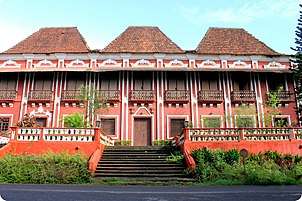 Top to bottom: the Church of the Holy Spirit, the Camara Municipal de Salcete, the Madgaon Konkan Railway station (L), the House of Seven Gables (R) | |
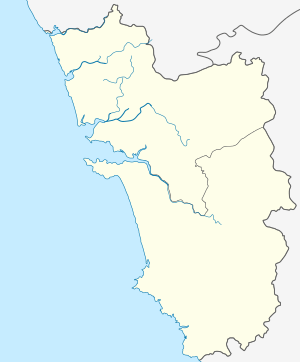 Margão Location of Margão in Goa  Margão Margão (India) | |
| Coordinates: 15°16′25″N 73°57′29″E | |
| Country | |
| State | Goa |
| District | South Goa |
| Sub-district | Salcete |
| Government | |
| • Member of Parliament, Lok Sabha | Francisco Sardinha |
| • Chairperson | Pooja Naik[1] |
| Area | |
| • City | 16.10 km2 (6.22 sq mi) |
| • Metro | 24.1 km2 (9.3 sq mi) |
| Elevation | 10 m (30 ft) |
| Population (2011) | |
| • City | 87,650[2] |
| • Metro | 106,484[2] |
| Demonym(s) | Madgaonkar |
| Time zone | UTC+5:30 (IST) |
| PIN | 403601/2 |
| Telephone code | 0832 |
| Vehicle registration | GA-02, GA-08 |
| Website | MMCMargao.gov.in |
Etymology
Margão is the Portuguese spelling, with Madgao being used in Konkani. It was called Madgaon in Marathi. It is derived from the Sanskrit मठग्राम (Maṭhagrāma) which means a village of monasteries.
In Ravanphond, now a suburb of Margao, there are shrines of Matsyendranath and Gorakhnath.[3] The abode of Nath medicants was called a Matha (Monastery). Madagao was called Mathagrama on account of Vaishnavite Math belonging to Dvaita sect which was founded in the latter 15th century and shifted to Partagali after the establishment of the Portuguese power.[4]
History
Margão in pre-Portuguese times was one of the important settlements in Salcete and known as Matha Grama (the village of Mathas) as it was a temple town with nine Mathas in temple schools. Its replacement in 1579 was destroyed by raiders. The present church was built in 1675.[5][6]
While the western side of the Holy Spirit Church developed as a market place, the settlement grew on the eastern side, that is, the Borda region, with the Holy Spirit Church, Margao at its core and extended outwards.
Camara Municipal de Salcete
The Municipality during the erstwhile Portuguese regime was known as "Câmara Municipal de Salcete",[7] catering to all the villages in Salcete Taluka for over 300 years until the Goa Municipalities Act of 1968 came into force. The Câmara Municipal de Salcete is now reconstituted into Margao Municipal Council. The Members of the Câmara Municipal de Salcete were then nominated by the Government, but after the reconstitution of the Municipal Council, the Members to all the 25 wards (13 in Margao & 12 in Fatorda) are elected by the Members of the council.
Margão's importance as an administrative and commercial area grew with the increasing dependence of the surrounding towns and villages; leading to the administrative center with the town hall at its center being built in the south.
In 1961, Goa was freed from Portuguese occupation and incorporated into India, and Margão was declared as the administrative center of the district of South Goa.
Geography
Margao is located at 15°16′25″N 73°57′29″E. It has an average elevation of 10 m (33 ft).[8]
By road, Margao is located approximately 33 km (21 mi) from the capital Panjim, and 27 km (17 mi) from Vasco da Gama.
Nestled on the banks of the Sal River, Portuguese style mansions dot its landscape. One of the fastest growing cities in Goa, its fast growing suburbs include Aquem, Fatorda, Gogol, Borda, Comba, Navelim and Davorlim.
Climate
Margao features a tropical monsoon climate. Summers are warm whereas winters are mild. Summers last from March–May when the temperature reaches up to 36 °C (97 °F) and winters from December–February when it is usually between 17–28 °C (63–82 °F). Monsoons occur from June–September with heavy rainfall and gusty winds. The annual average rainfall is 2,881 mm (113.4 in).
| Climate data for Margao | |||||||||||||
|---|---|---|---|---|---|---|---|---|---|---|---|---|---|
| Month | Jan | Feb | Mar | Apr | May | Jun | Jul | Aug | Sep | Oct | Nov | Dec | Year |
| Average high °C (°F) | 31.9 (89.4) |
31.7 (89.1) |
32.1 (89.8) |
33.0 (91.4) |
33.3 (91.9) |
30.4 (86.7) |
29.0 (84.2) |
28.8 (83.8) |
29.7 (85.5) |
31.7 (89.1) |
32.9 (91.2) |
32.6 (90.7) |
31.4 (88.6) |
| Average low °C (°F) | 19.8 (67.6) |
20.6 (69.1) |
23.2 (73.8) |
25.5 (77.9) |
26.4 (79.5) |
24.7 (76.5) |
24.3 (75.7) |
24.0 (75.2) |
23.9 (75.0) |
23.8 (74.8) |
22.2 (72.0) |
20.9 (69.6) |
23.3 (73.9) |
| Average precipitation mm (inches) | 0 (0) |
0.1 (0.00) |
0.6 (0.02) |
7.2 (0.28) |
97.1 (3.82) |
861.5 (33.92) |
899.8 (35.43) |
591.6 (23.29) |
256.3 (10.09) |
116.5 (4.59) |
33.9 (1.33) |
16.2 (0.64) |
2,880.8 (113.41) |
| Source: IMD | |||||||||||||
Demographics
As of the 2011 census of India,[10] Margao had a population of 87,650.[2] Males constituted 51% of the population and females 49%. It had an average literacy rate of 90%; male literacy was 93%, and female literacy 86.8%. In Margao, 9.8% of the population was under 7 years of age. With a population of 106,484 in the metropolitan area, Margao is second largest Urban agglomeration in Goa.[2]
Education
Margão is home to many schools and colleges, the alumni of which have made significant contributions to Goa's cultural and scientific landscape. Most schools function in accordance with the curriculum prescribed by the Directorate of Education and the Goa Board of Secondary and Higher Secondary Education.The oldest, the Loyola High School (Goa) near the Old Bus Stand, is a Jesuit-run school. Other prominent schools include Bhatikar Model English High School (established in 1935) named after its founder Late Pandurang Raya Bhatikar[11][12] and Mahila & Nutan High School which was established as Samaj Seva Sangh's Mahila Vidyalay for girls in 1933 and started co-ed intake in June 1972.[13] Schools affiliated to central boards include Vidya Vikas Academy which is affiliated to the CBSE board and Manovikas High School affiliated to the ICSE board.[14] The other educational institutes in Margão include St. Joseph High School[15] at Aquem, Govt. High School Vidyanagar, Holy Spirit Institute, Presentation Convent High School, Fatima Convent High School, and Perpetual Convent High School located in Navelim.
The colleges in Margão include The Parvatibai Chowgule College which was housed in Portuguese Military Barracks opposite Multipurpose High School in Vidyanagar. The college moved to its present location in 1972 under the direction of then principal Prof. P. S. Rege. Shree Damodar College of Commerce and Economics and Govind Ramnath Kare College of Law provide post secondary education in Commerce and Law respectively. Schools such as Shree Damodar Higher Secondary School Of Science and R.M.S Higher Secondary School focus exclusively on higher secondary education. There are also ITIs (Industrial Training Institutes) which impart technical education. Don Bosco College of Engineering located at Fatorda is the sole technical degree granting institute in the town.
Transport
Air
The nearest airport to Margão is Goa's international airport ( Dabolim Airport ) which is 23 km away.[17]
Rail

Madgaon railway station is a railway junction positioned at the intersection of the Konkan Railway and the South Western Railway and is Goa's busiest. Due to its location and connectivity, the station is often used as a transit stop by many people who either head off down south to popular tourist destinations such as Palolem (38 km) or to Benaulim and Colva which are about six kilometers away and are popular tourist destinations.
Margão hosted the test track for the Skybus Metro project,[18] an elevated rail system patented by the Konkan Railway Corporation,[19] This project was allegedly scrapped due to an accident which occurred during the test drive killing one engineer and seriously injuring three crew members.[20] B Rajaram who had invented the rail system has stated that in his opinion the accident was avoidable.[21]
Language
Konkani is the most widely spoken language in Margão, followed closely by English. Portuguese is still spoken and understood by a small number of people. Hindi is also spoken and understood by a majority of the city's population as a language to converse with non-konkani, non-English speaking people. The dialect of Konkani in South Goa differs notably from that spoken in North Goa. Marathi is also understood to a significant level. A sizable fraction of the flower and vegetable merchants converse in Kannada.
Tourism
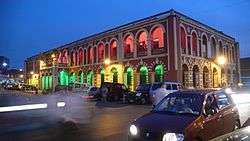
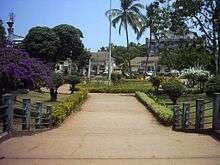
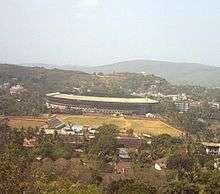
The town has many sights and destinations. These include the Mercado de Afonso de Albuquerque which roughly translates to closed market and colloquially known as "Pimplapedd" or "Pimpalakatta", the municipal building (Câmara Municipal), the municipal garden named after benefactor Prince Aga Khan, Anna Fonte (natural springs), Old Market or Mercado Velho, Holy Spirit Church, grand colonial mansions such as the Seven Gables House, the chapel at Monte Hill.
Some of the town suburbs include Pajifond, Aquem, Gogol, Borda, Malbhat, Madel, Kharebandh, Old Market, Navelim and Comba, the last two being the oldest parts of the town.
Pandava Caves Located in Aquem Behind St. Sebestian Church
There are a number of churches and temples in Margão, since the population has almost equal numbers of Hindu and Roman Catholic followers and a Muslim minority. The famous churches in Margão are the Holy Spirit Church, the Grace Church, The St Sebastian Church in Aquem (The Old St. Sebastian Chapel, popularly known as the Pandava Copel still stands next to the modern St. Sebastian Church) and the Monte Hill Chapel, the famous temples are the 'Damodar Temple' (Saal), the 'Hari Mandir', the 'Maruti Mandir' at Davorlim the 'Saibaba Temple' at Davorlim, the 'Shiv Temple' (Ling) at Fatorda near Nehru Stadium (which is the original Temple of Damudora). There are two mosques in Margão, one in the Malbhat area and one on the Monte hill. There is also a Jain temple and a Jama'at Khana for the Khoja faith in Pajifond. There is also a Muslim community of Nizaris living in Margão.
Landmarks
Municipal Garden
In the centre of the town is the Municipal Garden, known as Praça Jorge Barreto, around which most restaurants and office buildings are located. On the park's south side like the colonial style red-washed Municipal building, known as Margão Town Hall which was built in 1905, and the Library. The northern segment of the Municipal garden was developed by the Mavany family and is named after His Highness Prince Shah Karim Al Hussaini, Aga Khan IV/Imam of Nizari Ismaili Muslims who visited Goa just before its liberation. The entire garden is now municipal property and is maintained by the Margão Municipal Council.
The Holy Spirit Church
The Largo de Igreja, or the Church of the Holy Spirit, was built by the Portuguese in 1675 and boasts a pristine white façade and an interior dripping with gilt crystal and stucco. The Municipal Garden square is defined on one side by the church with its baroque architecture and the parochial house, and on the other side by the palatial mansions of affluent elite Catholics, positioned in a row. The Associação das Communidades (Communities Association) building and the school being the odd exceptions which add to its character and sense of scale. They have a maximum height of two stories, and balcões balconies and varandas (verandas) facing the square. Parallel to the church square is the commercial street (old market). There is also a landscaped area next to the church called Praça da Alegria (Joy Square). The church feast is celebrated before the monsoons, it is a time when many residents make pre-monsoon purchases to stock up for a prolonged rainy season.
House of Seven Gables
Just within walking distance of the Holy Spirit Church, is the famous "House of Seven Gables" or "Sat Burzam Ghor". This magnificent mansion was built by Inacio Sebastiao da Silva, emissary and private secretary of the Portuguese Viceroy, in 1790. Today, only three of the seven gables remain. The family church with its Baroque and Rococo workmanship, exhibits the loftiness of the Portuguese time.
Narcinva D. Naik residence and Damodar Sal
The Narcinva D. Naik residence houses Margao's well-known temple-hall known as Damodar Sal or Dambaba Saal. The house played host to Swami Vivekananda during his visit to Goa in October 1892 before proceeding to Chicago to address the Parliament of Religions[22]
Damodar Temple
The initial settlement of Margão grew from the site of the ancient Damodar Temple. The original temple was demolished and the temple tank was filled up to be replaced by the Holy Spirit church and church grounds. The deity Damodar (a form of Lord Vishnu) was carried across the Zuari Agranashini river to the Novas Conquistas in which the Sonde rulers resided.
Culture
The town is also claimed as the cultural capital of Goa. A cultural center named 'Ravindra Bhavan' was inaugurated by the then Chief Minister of Goa, Digambar Kamat in July 2008 at Fatorda which is also an Official Venue For International Film Festival of India . It also has Goa's biggest sports stadium, the Nehru Stadium at Fatorda.[23] The Akhil Bharatiya Marathi Sahitya Sammelan was held in 1964.[24]
Some of the theatres in Margão include the Gomant Vidya Niketan, OSIA Multiplex, Vishant and Lata; in addition to Goa's biggest theater, the Metropole. Inox has recently launched a multiplex with a capacity of 904 seats. The Gomat Vidya Niketan is a premier centre for arts in the town.
People from all over Goa congregate at the special market to buy spices and dried fish to be used during the oncoming rainy season.
The usual specialities that are found in the cuisine of Goa are also to be found in Margão. The curry of Margão is a praised local speciality. Cans of curry of Margão are currently exported to Portugal and elsewhere.
Margão is also the name of a brand of spices sold in Portugal.
Gallery
- Life in Margao
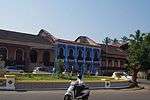 Margao, India
Margao, India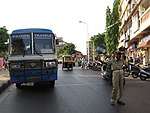 Margao Crossing Guard
Margao Crossing Guard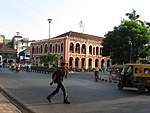 Margao Municipal Building
Margao Municipal Building Rickshaw Stand
Rickshaw Stand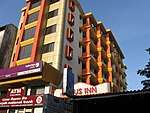 Modern Margao
Modern Margao- Madgao Municipal Council Bldg
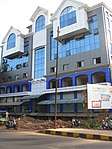 New buildings under construction
New buildings under construction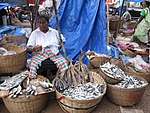 Vendor at Margao Fish Market
Vendor at Margao Fish Market Can of curry from Margão, in Portugal
Can of curry from Margão, in Portugal- Old and new Igreja de São Sebastião - St. Sebastian Church in Aquem
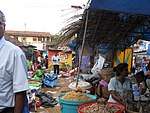 Fish Market
Fish Market Casa de Saúde, Margao
Casa de Saúde, Margao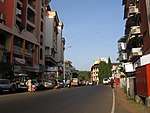 Street in Margao
Street in Margao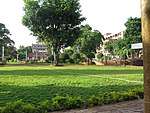 Margao Municipal Park
Margao Municipal Park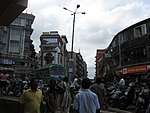 Busy Margao Intersection
Busy Margao Intersection.jpg) Margao, India
Margao, India Margao Station Main Platform
Margao Station Main Platform Beach close to Margao
Beach close to Margao Igreja do Espírito Santo, Holy Spirit Church, Margão
Igreja do Espírito Santo, Holy Spirit Church, Margão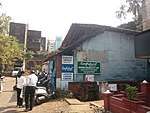 Confidant House, Margao, west elevation. The building contains a library and bookshops.
Confidant House, Margao, west elevation. The building contains a library and bookshops. Margao, India
Margao, India Statue of Ram Manohar Lohia in Lohia Maidan
Statue of Ram Manohar Lohia in Lohia Maidan Margao Post Office
Margao Post Office
See also
| Madgaon (MAO) | ||||
| Next 'Small' station towards Mumbai: Majorda |
Konkan Railway : Railway (India) | Next 'Small' station from Mangalore: Balli |
||
| Distance from Mumbai(CST) = 765 km | ||||
| Next 'Main' station towards Mumbai: Kudal |
Konkan Railway : Railway (India) | Next 'Main' station from Mangalore Karwar | ||
References
- "GOA FORWARD GRABS 'MARGAO MUNICIPALITY' AGAIN", Prudent Media, 22 November 2019, retrieved 22 November 2019
- C. Chandramouli (2015) [2010–11], "Margao Urban Region", Office of the Registrar General and Census Commissioner, India, Government of India, Census Organization of India
- Satoskar, B.D (1979). Gomantak: prakṛitī āṇi saṃskṛitī. Śubhdā-Sārasvat. p. 113.
- Mitragotri, Vithal Raghavendra (1999). A socio-cultural history of Goa from the Bhojas to the Vijayanagara. Institute Menezes Braganza. pp. 151–152.
- "Hindu temples and deities" by Rui Gomes Pereira
- "Gomantak Prakruti ani Sanskruti" by B.D.Satoskar
- "Madgaon, India Page", Falling Rain Genomics, Inc, retrieved 28 June 2017
- Margao Population Census 2011 #Margao Religion Data 2011. 2011 Census of India (Report). Government of India. Retrieved 6 September 2017.
- C. Chandramouli (2015) [2010–11], "Goa State Tables" (PDF), Office of the Registrar General and Census Commissioner, India, Government of India, Census Organization of India
- Bhatikar Model High School. Margao, Goa, India Archived 3 May 2014 at the Wayback Machine
- Bhatikar Model High School. Margao, Goa, India Archived 30 August 2014 at the Wayback Machine
- About Us | Mahila & Nutan English High School
- Welcome to iSchool
- St Joseph High School, Margao (GOA)
- "Airports Authority of India". Aai.aero. 21 September 2011. Archived from the original on 21 April 2012. Retrieved 9 May 2012.
- Skybus page from konkanrailway.com
- Patent of Skybus from konkanrailway.com
- Accident details. Hindu.com (2004-12-23). Retrieved on 2012-04-27.
- ACD article 20 July 2010. Docs.google.com. Retrieved on 2012-04-27.
- News article from Archived 29 October 2006 at the Wayback Machine. goacom.com. Retrieved on 2012-04-27.
- Cricinfo page on Nehru Stadium. Content-usa.cricinfo.com. Retrieved on 2012-04-27.
- Rediff On The NeT: Kusumagraj dies at 87